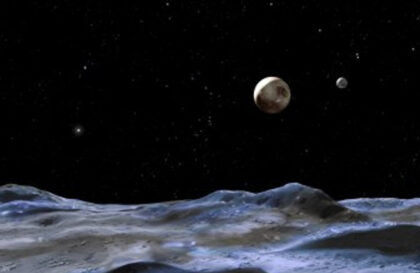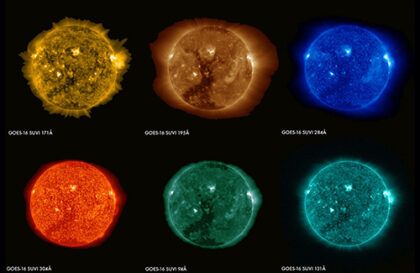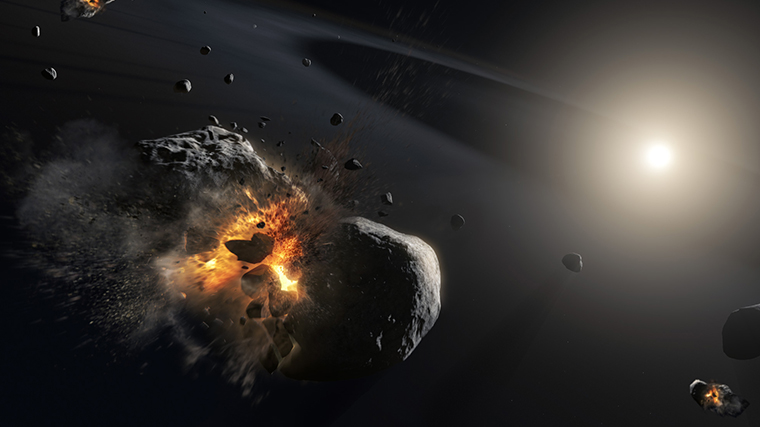The Sun rotates on its axis, making one revolution every 25.38 Earth days. This rotation is responsible for the formation of sunspots, solar flares, and other solar phenomena. The rotation of the Sun is uneven; different parts of the Sun rotate at different speeds. The equator rotates faster than the poles, making one revolution every 25.05 days, while the poles take about 36 days to complete one revolution. This differential rotation is related to the Sun’s internal structure, with the outer layers rotating faster than the inner layers.
Credit: NASA
The Sun also revolves around the center of the Milky Way galaxy, completing one revolution every 220 million years. The Milky Way is a spiral galaxy, and the Sun is located in one of the spiral arms, about 26,000 light-years from the galactic center. This movement is influenced by the gravitational pull of other stars and objects in the galaxy as the Sun and its planets move in a complex dance around the galactic center. The period of rotation of the galaxy around its axis, the period of rotation of the Sun around the galaxy’s center, and the distance that light travels to the Andromeda galaxy are interconnected.
Our sun is located about two-thirds of the way out from the center of the Milky Way. Credit: Caltech.
The Sun is part of a group of stars known as the Local Interstellar Cloud, which moves through the interstellar medium at about 26 km/s. This movement is affected by the gravitational attraction of nearby stars and other objects and the expansion of the universe. The movement of the Sun relative to other stars can be observed by its apparent movement across the sky, as well as by the Doppler effect, which causes a shift in the frequency of light emitted by moving objects.
The rotation of the Sun and its influence on the Solar System
As the Sun rotates on its axis, it creates a gravitational pull that affects the motion of the planets around it. The planets move around the Sun in elliptical orbits, and their speed and distance from the Sun depend on its rotation. The Sun’s rotation affects the planets’ speed and direction, which can lead to changes in the length of the planet’s year and the shape of its orbit. The rotation of the Sun also affects the orientation of the planets’ orbits, which can affect the tilt of their axis and the seasons.
As the Sun rotates, it creates a dynamo effect that creates a magnetic field that can cause sunspots to form on its surface. Sunspots are regions of intense magnetic activity that appear as dark spots on the Sun’s surface.
As the Sun rotates, it can create regions of intense magnetic activity that can lead to solar flares. These flares can significantly impact Earth’s environment, including disrupting power grids and communications systems. The frequency and intensity of solar flares are influenced by the 11-year cycle of the Sun’s magnetic activity, which, in turn, is controlled by its rotation.
Factors influencing the rotation of the Sun
The Sun’s rotation is affected by several factors, including gravitational forces and angular momentum. The Sun rotates on its axis, which is inclined at an angle of approximately 7.25 degrees relative to the ecliptic plane. This rotation results from the angular momentum present in the cloud of gas and dust that formed the Sun and the Solar System. As the cloud collapsed, it began to rotate faster, and this rotation was maintained as the Sun formed at the center of the spinning disk.
Comparison of the rotation of the Sun with other stars
The universe has different types of star rotation, and the sun’s rotation is unique compared to other stars. The sun rotates on its axis but not as a solid body. The Sun’s angular velocity decreases with distance from the equator, which is different from other stars that rotate uniformly. As stars age, they lose mass, which can cause them to spin faster.
Banner image: The sun does indeed rotate, and its rotation isn’t difficult to measure, because the thin solar surface has features such as sunspots and prominences, some of which last long enough to be observed. Credit: WIKIMEDIA COMMONS (free-content)
Image credit:
https://science.howstuffworks.com
https://www.space.com
https://earthsky.org






